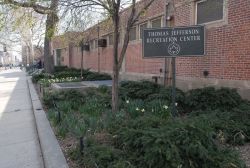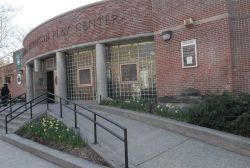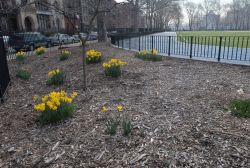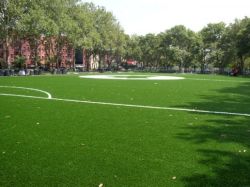Thomas Jefferson Park
The Daily Plant : Thursday, October 6, 2005
THOMAS JEFFERSON PARK TURNS 100 AND LOOKS TO THE FUTURE

collage by John Mattera
On October 7, 1905, President of the Parks Board John J. Palls presided over the opening of Thomas Jefferson Park. This Saturday, October 8, 2005, Parks & Recreation Commissioner Adrian Benepe will preside over the park’s 100th anniversary celebration.
In the late 19th century, the City’s leaders were working to fulfill the vision behind the State Legislature’s 1887 Small Parks Act. In 1894, the Board of Aldermen (predecessor to the City Council) conceived of Thomas Jefferson Park, to be built in an area that had historically been called the Harlem Flats, but slowly became known as Little Italy. The name referred to the growing community of Italian-Americans who migrated from the Lower East Side by means of the Third Avenue el.
Ironically, photojournalist/reformer Jacob Riis, whose efforts helped fuel the reform movements that created our turn-of-the-century playgrounds, took issue with the naming of this and all parks for people, while, at the time, public schools were known by numbers only. In his 1902 book The Battle With the Slum, he wrote:
One alderman got the idea during the Strong reform administration, but they hitched the names to the new parks instead of the schools, and that turned out wrong. So they have the Ham Fish Park for Hamilton Fish, the "Sewer" Park for William H. Seward, the Thomas Jefferson Park uptown which no one will ever call anything but the Little Italy Park, and the good name of De Witt Clinton put to the bad use of spoiling beautiful "Hudsonbank."
Perhaps Riis would be pleasantly surprised to know that the name Thomas Jefferson did stick, and Seward is as seldom mispronounced as it was then (however, the nickname "Ham Fish" is still used today). This little example reminds us that some things change for the better, some things change for the worse, and some things just don’t change.
Over the course of the past hundred years, Thomas Jefferson Park certainly did change, but these changes were motivated by the essential Parks mission, which has not changed: to provide a public space for the people of the community to gather, relax, and recreate. As was the style at the time, Thomas Jefferson Park opened with playground equipment; a "kindergarten;" and a pavilion with a sheltered porch for mothers, a comfort station, and public baths. (It stood at about 112th Street and Riverside Drive until it was decimated by vandals in the 1970s).
In 1911, a section of Thomas Jefferson Park was divided into 1,008 miniature farm gardens, a practice that was a trend of the time. Many parks were employed in this way, the thought being that city kids needed to commune with nature and understand agriculture. When Commissioner Robert Moses took office, he sensed that kids would be more interested in an Olympic-sized swimming pool, and so he had one built there. His bet has paid off every summer since 1936.
Once again taking action to respond to the needs of the community, in 1992 Parks completed a $10.5 million renovation of the entire property, investing not only in the grounds but also modernizing the recreation center. Most recently, in 2003, Parks responded to yet another change in the community’s needs by constructing an artificial turf soccer field at Thomas Jefferson.
Thomas Jefferson Park was built because the people needed it. Similarly, it has changed over the past hundred years to suit the people’s needs, and Parks & Recreation looks forward to changes Thomas Jefferson Park will undergo to remain a fun, pleasant, enriching facility for the next hundred years. See you in 2105.
-written by John Mattera
QUOTATION FOR THE DAY
"No occupation is so delightful to me as the culture of the earth, and no culture comparable to that of the garden."
Thomas Jefferson
(1743-1826)
Check out your park's Vital Signs
Clean & Safe
Green & Resilient
Empowered & Engaged Users
Share your feedback or learn more about how this park is part of a
Vital Park System









